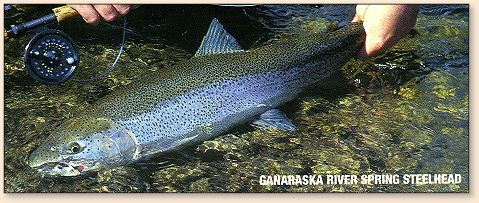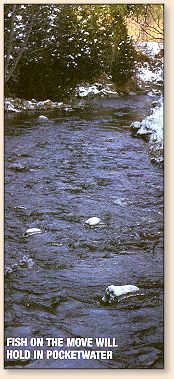Great Lakes Spring Steelhead
Tactics for Small Streams
By Chris Marshall
I shall never forget my first Great Lakes steelhead.
I was fishing the Wolf River near Nipigon in the fall
of 1968 after moving to Fort William (now Thunder Bay)
that summer. Although I cannot now remember whether
the month was October or November, the years have
not dimmed the image of that fish as it came to my
hand in the late afternoon-burning bright silver
among granite boulders in the dark water under a
grey sky.
I remained at the north end of Lake Superior for
just three years. I fished often-anywhere and for
anything, but it was the steelhead which fascinated
me most. Although I fished for them at every
opportunity, they remained elusive. My success was
sporadic, despite the local knowledge and mentoring
of my usual fishing partner, Tom Mikulinsky, a Grade
12 student at Sir Winston Churchill Secondary School
where I taught. While we caught fish, all too
frequently we seemed to miss the main run, arriving
at the water either too early or too late. Perhaps
the problem was me, for often when Tom went without
me, he managed to get the timing right.
Consequently, although I welcomed the kinder climate
and superb warm water fishing when I returned to the
Quinte region in 1971, the elusive, enigmatic
steelhead far to the northwest continued to haunt
me.

Then, I discovered the steelhead of Lake Ontario.
Again, it was one of my students who opened the
door, when he took me to Lakeport one April in
the mid-seventies. Since then, I've pursued the
dream in the smaller, gentler streams of central
Lake Ontario, and although these lack the enthralling
wildness of their counterparts in the north, they
suffice.
Fall or Spring?
The Lake Ontario tributaries east of Toronto are
small, and although steelhead start gathering at
the mouths of these in the fall, few penetrate far
upstream until the spring. This is unfortunate, as
steelhead are brighter, firmer and more energetic
in the fall than they are in the spring. However,
as rain and snowmelt begin to swell the flow in
March, the streams fill with fish, and the fly
fishing opportunities are overwhelmingly greater.
These fish have hung around the mouths of the
tributaries throughout the winter, making occasional
forays a short way upstream when the occasional mild
spell increased the flow, but dropping back to the
lake as the flow diminished with the return of
sub-zero temperatures. In milder years, there will
be enough fish in the lower reaches to provide good
fishing as early as February, but usually this does
not happen until March. The run, however, tends to
peak in the first part of April. In normal years,
most steelhead will have spawned by the end of April,
although there are always a number which procrastinate
until early May.
Once they've spawned, some fish will start dropping
back to the lake within days, while others will hang
around, holding in the deeper pools until as late as
June. Rain is the major factor in determining the
timing of this return migration: the more rain,
the higher the flow and earlier the return.
Tactics: Stream
 On mild days in winter, it's possible to target the
fish hanging around the stream mouths, provided there's
no onshore wind pushing the ice pack against the shore
and clouding the water with silt. In such conditions,
steelhead tend to stay offshore where the water is
clear.
On mild days in winter, it's possible to target the
fish hanging around the stream mouths, provided there's
no onshore wind pushing the ice pack against the shore
and clouding the water with silt. In such conditions,
steelhead tend to stay offshore where the water is
clear.
Stream mouths vary. Some are deep, slow-moving channels,
little more than inland extensions of the lake, which
offer excellent opportunities for bait and hardware
fishers, but little for fly fishers. Others, however,
are channels through the shoreline gravel, with
streamy flows thrusting out into the lake. These
are the places to fly fish. The best tactic is to
wade into the lake itself adjacent to the flow and
fish a streamer on a swing across and down, finishing
with an upstream strip, or cast a nymph, Woolly Bugger
or egg imitation upstream and dead drift it back until
it starts to lift downstream. In both cases, the fly
must be fished close to the bottom where the fish
inevitably hold.
Sometimes in mild spells in March, the flow will cut
a channel through the shoreline ice pack, creating
an extension of the stream out into the lake.
Encountering this is serendipity, as it can be
fished as if it were a regular stream running
between terrestrial banks. Fish will frequently
hold along the undercut ice edges.
Tactics: The Streams Themselves
Once steelhead have entered the stream in earnest,
in late March and early April, they'll stay in the
stream even in dry conditions when the water is clear
and the levels relatively low. This is the best time
to target them, rather than when the water is running
high and stained. Many will be holding in the pools and
deeper runs, but don't neglect pocket water, for a
number will also hold there, even in tiny pockets
which most anglers overlook.
While the pools and deeper runs can be fished blind,
either with a swung streamer or a with a dead-drifted
nymph or egg pattern, the best tactic is to sight fish.
Pocket water in riffles is ideal for this. Moreover,
the bait fishers, who crowd the popular pools, rarely
bother with these places.
Once fish or likely lies have been located, get as
close as you can downstream or across, cast the fly
upstream, and drift it down. If you can see the fish,
drift the fly as close to the fish's nose as possible
and watch for the white glint of an opening mouth
before setting the hook. If you can't see the fish,
set the hook at any check or unnatural movement of
the drifting leader-however, insignificant. Make sure
you use enough weight on the leader or the fly to
ensure the fly trundles along close to the bottom.
Always fish as short a line as possible and leave
as short a portion of the line as possible on the
water, for this enables optimum line control and
detection of takes. This means that there's rarely
any need for a strike indicator if you're using a
short leader, as the short length of line on the
water serves this purpose. Moreover, much of the
time, you should be able to see the fish you're
targeting and watch it take. This is a far more
effective method of detecting a take than watching
a strike indicator or the line. While you should
make your approach to fish or likely lies as sneakily
as possible, you'll find that steelhead are much
less easily spooked than resident trout, and that
its possible to get quite close to them. Moreover,
because the banks of these small streams are often
heavily bushed, making conventional casting difficult,
a close approach enables short flip casts and roll
casts, eliminating the need for a back cast and the
inevitable hang-ups in streamside branches.
Locating Fish
Migrating steelhead usually hold in or close to cover.
Turbulent pockets and deep holes in pools can provide
this, but outside these places, they will tend to lurk
by deadfalls, overhanging tree branches, boulders,
tree roots and undercut banks. The best tactic is to
walk stealthily upstream and scrutinise all likely
places. While it doesn't take long to recognise the
lies, the fish are not always easy to spot, and it
takes some time and practice in order to become adept.
Nevertheless, the fly fisher who perseveres will be
rewarded with greater success on the water.
Gear
Although these Lake Ontario tributaries are
small, the steelhead which enter them can be
big-as much as twenty pounds or more. At the
same time, because they're small, there's no
need for gear designed for long casts. Therefore,
the rod should have enough backbone to handle
big fish in tight spaces, yet also have the
facility for making short, delicate casts. A
nine foot-weight loaded with a weight-forward
number eight floating line is ideal. The long
rod facilitates line control, and the heavier
line helps in making short casts.

Because handling big fish on these small streams
involves following them on foot, rather than
letting them run and playing them on the reel,
there's usually little need for a big reel with
a sophisticated drag or lots of backing. The leader
should be short, between four and six feet, with
a tippet no lighter than six pounds test. Eight
pound test is better, especially where it's necessary
to play fish tightly to keep them out of snags.
Flies
While there are situations where streamers are
effective, most situations are best fished with
dead-drifted nymphs and egg patterns.
Streamers: Avoid bulky winged patterns
which are hard to get down near the bottom and
keep there. Concentrate instead on sparsely-tied
hair wings on #6 and #8 hooks. Patterns which
suggest smelt and alewives are good at the stream
mouths and the lake shore. Traditional hair wings
with a touch of flash and bright red or chartreuse
work well in the streams themselves.
Flies for Dead-drifting: While most small
stream steelheaders have their own personal
favourites, most buggy, impressionistic nymph
patterns are effective. However, it's hard to
beat the ubiquitous Woolly Bugger (sizes #10 to
#6) in subdued, natural colours, especially black.
Shellbacks (#10 and #8), such as the Spring Wiggler
in fluorescent orange, yellow, and chartreuse also
work well. Single egg patterns tied on short-shank,
wide-gape hooks in fluorescent red, orange, yellow,
chartreuse, or combinations of these are also good,
especially with a few strands of Krystal Flash tied
in at the tail. ~ CM
Credit: Excerpt from the January/March 2004
issue of The Canadian Fly Fisher. We appreciate use
permission.
Our Man In Canada Archives
|

